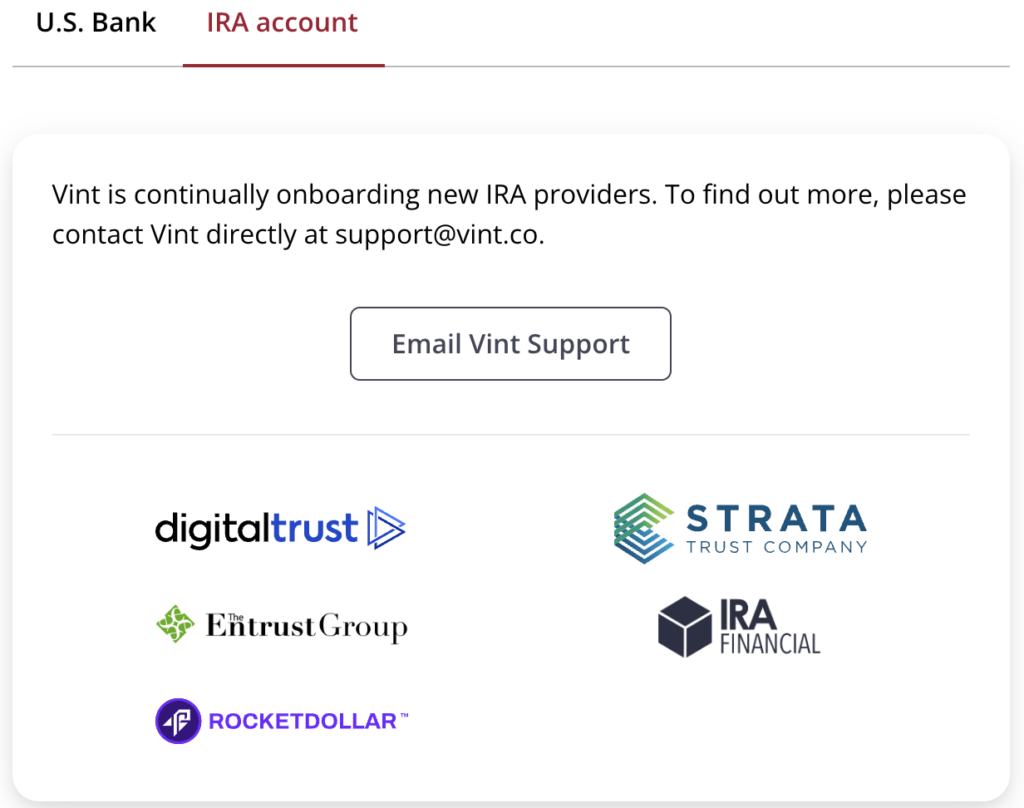Do you want to invest in wine, whiskey, and spirits for uncorrelated appreciation? Find out whether Vinovest vs Vint is the right fit to get started in 2024.
Introducing These Wine Investing Platforms
Both Vinovest and Vint are newer investment platforms following the emerging trend of increasing the accessibility of alternative assets for retail investors. They are exclusively dedicated to investing in wine, whiskey, and spirits.
Vinovest Vs Vint – Similarities
Outside of being focused on the same asset class, there are not a large number of similarities between these two platforms.
Vinovest Vs Vint – Summary
Both of these platforms offer respectable options for investing in wine and spirits. Each platform also takes care of safely storing and insuring the wine. However, the approaches they take to developing their offerings are very different.


Vinovest allows both accredited and non-accredited investors to directly own cases and bottles of wine. Vint requires you to be accredited but makes it easy to diversify with a single investment through their funds.
Vint bakes their fees into the offerings and doesn’t collect any payments from investors. Vinovest collects monthly management fees. Vint lacks liquidity while Vinovest has ample amounts.
Overall, each platform has their strengths and drawbacks. Vinovest is the best place for non-accredited investors to get started. For accredited investors, Vint’s fund-based offerings provide a simple way to get exposure to specific investment strategies.
For anyone that wants liquidity or to directly own the bottles they are investing in, Vinovest is the best option.
Vinovest Vs Vint – Differences Deep Dive
How different can wine investment platforms be? As we’re about to see, quite different.
Types Of Offerings
Vint has one type of offering, while Vinovest has several. These provide investors different approaches to getting exposure to the asset class.
Vint Offerings
Vint provides investors the opportunity to purchase shares of “portfolios.” These offerings contain an assortment of bottles or casks arranged for a theme. For example, a portfolio may be focused on a diversified set of rare Japanese whiskey.
As with many fractional investing platforms, each offering (“portfolio” in this case) is actually an LLC. Investors are purchasing shares of that LLC. These are offered under Regulation D or “private placements.”
Vint Legacy Offerings (Before 2024)
Vinovest Offerings
Vinovest is not a fractional investing platform and is not regulated by the SEC. A portfolio with them will be made up of actual, physical bottles or cases of wine that you own. Vinovest takes care of the storage and insurance, as well as providing the tools to buy, sell, and manage your portfolio.
Wine investing with Vinovest has two different forms of offerings, managed and trading.
Managed
Managed offerings are an automatic investment solution, with an advisor available at higher account tiers. Investors deposit funds into their account and wines will automatically be selected, purchased, and added to your portfolio. There isn’t a minimum investment per se, but it typically requires at least $500 for a purchase to be made.
Trading
Trading accounts can buy individual bottles of wine from a primary or secondary market. Periodically there are new collections that are launched for purchase on the primary market. After that, bottles can be bought and sold between investors on the secondary market. The prices vary widely, ranging from below $100 to over $1000.
Whiskey
There is also a newer offering being made increasingly available to investors called Whiskeyvest. The Whiskeyvest page allows investors to reserve a cask of American Whiskey or Ultra-Rare Scotch. Beyond the reservation, the rest of the investment experience largely mirrors that of a managed account.
Vinovest vs Vint – Who Can Invest
Vinovest is available to a much wider investor base. Vint is exclusive to accredited investors while Vinovest is available to anyone that can legally drink in almost all countries.
Fees
Properly storing and insuring wine and spirits for years at a time definitely has a cost, so we can expect to see that reflected in the fee and cost structure of both platforms.
Vint Fees And Expenses
The fees Vint charges varies based on the specific offering. Here is what you may see:
- Sourcing Fee – A one-time fee paid “up-front” when the investment is finalized. This is typically 5% of the principal.
- Performance Fee – This is a profit share between investors and Vint. Once performance exceeds a certain threshold (the “hurdle”), additional profits are then split. The performance fee is typically 20%, though the hurdle can vary significantly between offerings.
- Management Fee – An annual fee charged to investors. This can be either based on the principal investment amount, or the assessed value of the fund (AUM). This has been the least common type of fee so far. Expect it to be between 1-2%.
Legacy, Non-Accredited Offerings
Vinovest Fees
Storing and insuring your wine or whiskey has ongoing costs. Vinovest charges a fee for this on a monthly basis for both managed and trading accounts.
- Managed Accounts (both wine and whiskey)
- Starter Tier – 2.5% per year / ~0.208% per month
- Plus Tier – 2.35% per year / ~0.195% per month
- Premium Tier – 2.15% per year / ~0.18% per month
- Grand Cru Tier – 1.9% per year / ~0.158% per month
- Trading Accounts
- 1.5% per year / 0.125% per month
After purchasing a bottle, there’s an up-front 2.5% fee. This also covers 3 months of storage and insurance costs (basically the management fee). This effectively makes the first year management fee 1.875%.
For trading accounts, there’s always a 1% fee for selling wine to another user.
For managed accounts, there is a 1.5% fee for selling wines on the marketplace. If wines are held until they reach maturity, a sale will also be brokered by the Vinovest team. They state there are no additional commissions taken on the sale. We take this to mean there are no additional fees if wines are sold in this way.
Vinovest states they will charge an additional 3% fee for users that sell wine in less than 3 years. For whiskey, the early liquidation fee is 10%.
Below, I have attempted to model out the fees for both a managed account, as well as a trading account. It uses the following set of assumptions:
- A $10,000 initial investment
- The value of the investment grows linearly at 1% each month
- Investments are held for 10 years and then sold
- Trading accounts face a 1% selling fee at the end of the 10 year period
- Managed accounts sell within the ideal selling / maturity window and face no additional fees
- Vinovest does not change the fees over the period of time
In this example, the investment is worth almost exactly $33,000 after 10 years. That’s a $23,000 gain in investment value. The Trading user paid $3446 in fees, while the Managed, Plus Tier customer paid $4550.
Liquidity
When making an investment, it is always good to understand what the options for liquidity are. Can you sell your investment early if you need or want to?
In the case of Vinovest, the answer is simply “yes.”
Trading accounts have assets that are already tied into their wine marketplace. Your fine wine bottles can easily be listed for sale. Likewise, managed accounts can also pursue a sale or liquidation at any time. There will be fees associated with these transactions, however.
For Vint, the answer is no.
There is no secondary market to sell your shares to other investors. There are also no options to exit after a set period of time. Once you purchase shares from Vint, you’ll have to hold them until the fund is liquidated.
Vinovest Vs Vint – Taxes
If your investments are successful, you’ll exit them with gains. How those gains are taxes is an important consideration when evaluating the valuation proposition of an investment.
Vint’s collections are Limited Liability Companies that operate like corporations from a tax perspective. When part or all of a collection is sold, investors will effectively receive a qualified dividend payment.
Vinovest has a completely different structure. Since investors own the wine and whiskey directly, they’ll be subject to collectibles taxes.
Both collectibles and qualified dividends are taxed like capital gains, with one exception. This could mean that investors pay the same tax rate between Vint and Vinovest. However, while capital gains are generally capped at 20%, one exception is collectibles which can be taxed up to 28%.
Vint’s structure keeps tax forms simple, requiring only a 1099-DIV. Vinovest seems to suggest that they will not provide investors with any tax documents.
Automatic Investment
If periodic, automatic investing strategies are your preferred investing approach, then Vinovest’s managed account is your only option here.
The portfolios offered on Vint and Vinovest’s trading accounts all require irregular, manual investments.
Payment Methods
Vinovest offers a wider array of payment methods supporting cryptocurrency from BitPay, check, and wire transfer. Vint supports payments from a bank account as well as select self-directed IRA providers.

Read More
To support an ad-free experience, we may earn a commission from links on this page.


